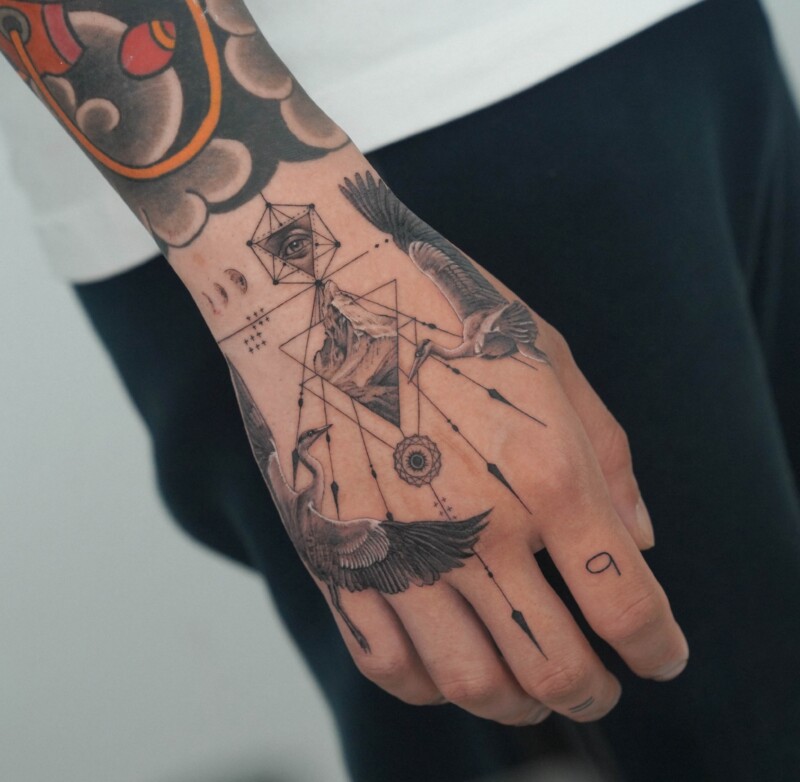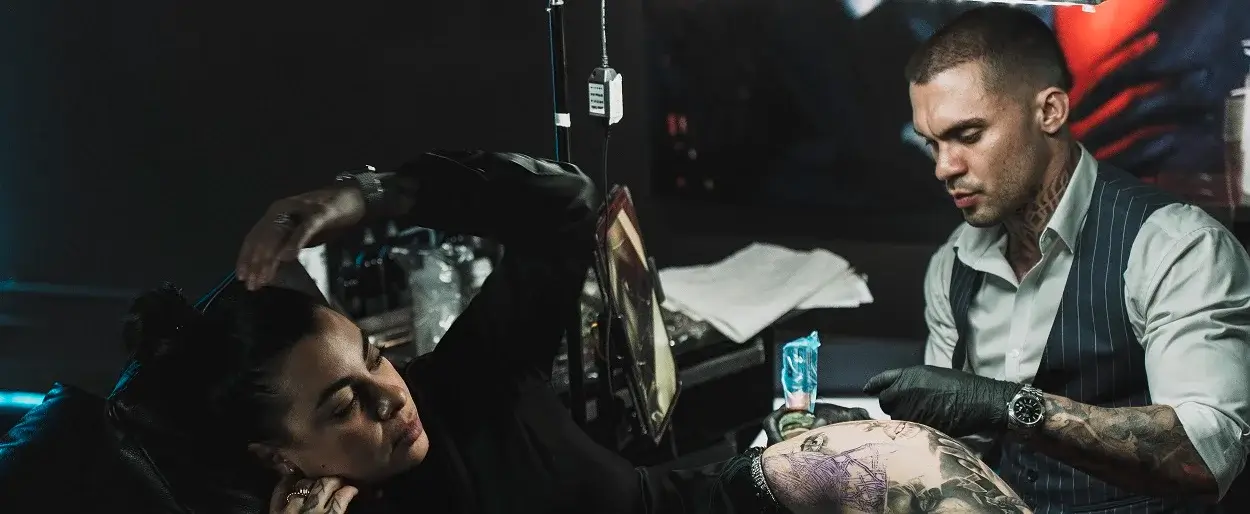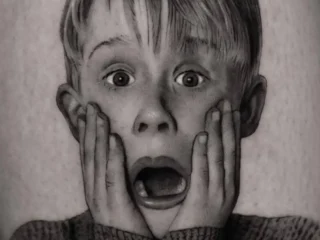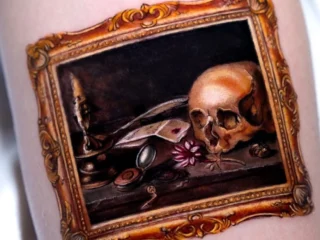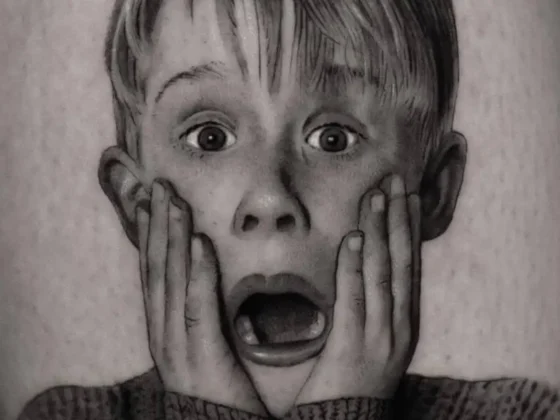Inked Mag Staff
February 7th, 2024
OGI TATTOO
Meet Ogi, a South Korean tattoo artist renowned for his fine lines and detailed black and grey work.
From early artistic endeavors to a transformative military service that introduced him to the diversity of tattoos, Ogi’s journey is a testament to passion and perseverance. Now, at BK Studio, he blends traditional and innovative techniques to create unique body art. This interview unveils Ogi’s path from inspiration to mastery in an art form still navigating legal recognition in Korea.

- Can you introduce yourself and briefly explain the story of your artistic journey?
Hi, I’m Ogi. I work at a BK Studio in South Korea, and I specialize in a combination of fine lines/black and grey with detailed descriptions. From a very young age, I loved drawing. I naturally grew up with a much better understanding and skill in drawing than others. And thanks to my parents who supported this, I was able to do a variety of art-related studies. I graduated from art high school and majored in video design at a prestigious university. While I was in university, I joined the military under the duty of the Republic of Korea. The military was a place where one could meet a wide variety of people. I saw a lot of people with tattoos there. It was interesting to me that the canvas was not paper, but the human body, and I was instantly fascinated by the uniqueness of the art, which was different from the art I had seen before. At the same time, I thought, “Oh, I think I can do better if I do it.” From then on, I dreamed of becoming a tattoo artist. After I was discharged from the military, I started learning skills to become a tattoo artist, and I have been since 2017. - When did your interest in art first spark?
When I was young, my uncle drew a Son Goku character on paper. When I saw the cartoon character on TV drawn with my uncle’s hand, I thought it was cool. I wanted to be good at drawing like my uncle. After following along a few times, I found out that I could draw pretty well. I loved drawing and was happy when I drew.
- What motivated you to specialize in dot work, sketch, fine-line, and black & gray tattoo styles?
I respect a tattoo artist named Oscar Akermo. The traditional black & gray genre may feel a little heavy because it fills all spaces without any space. I think he is the first tattooist to express an understated margin and rich tattoo according to the line flow of the human body among tattooists focusing on the black & gray genre. To build my own style, based on the inspiration I got from him, I am also researching and trying to harmoniously express the beauty of the interaction between black & gray and geometry to create a design that is both understated and rich, and able to flow the lines of the human body. - How did your tattooing career begin, and did you undergo any apprenticeships?
Since tattoos are illegal in Korea, there is no educational institution to train tattoo artists. I thought that if I had to learn person-to-person, I would like to learn from the best tattooist in Korea. At that time, I thought @bk_tattooer is the best. I was able to reach out to bk through social media, and I was able to learn a lot of knowledge about tattoos from him. And the apprenticeship wasn’t that long. I majored in art and was confident in drawing, so I started my career as a tattooist when I was able to handle machines as well as my own hands. - Can you briefly describe your distinctive signature style and its development?
For my tattoos, the most important thing is basically a design that flows along the muscle line of the area desired by the customer. At the same time, geometric elements were used to create the beauty of blank space. I wanted to differentiate it from the existing traditional black and grey tattoos, dense coloring on the skin, and a style that I sometimes feel is too much for me. This way, each customer’s unique skin color can be brought out and harmonizes well with the tattoo. In a word, is a style with understated richness and sexiness black and grey tattoo style. In terms of design, I think there is no end point, so I am constantly trying to raise the visual level through various art media, exhibitions, and viewing antique buildings. Until the day when the black and gray genre can be loved by both men and women of all ages, I will keep trying to complete a style that can show restrained weight and sophisticated beauty.
- Could you share insights into the tattoo scene in South Korea?
In Korea, the perception of tattoos was not good until 20 years ago. Because the rogues had tattoos like Irezumi, and the tattoos were thought to belong only to them. When I think about when I was young, I thought the tattoo only had Irezmi style. I think the perception of tattoos has been alleviated a lot, as various tattoo genres are introduced into Korea and meet these generations who proudly express their individuality. These days, if you walk down the street in Korea, you can see that one in ten people has a tattoo. From these things, we can see that Koreans’ views on tattoos have changed. But contrary to the changed view, tattoos are still being designated illegal in Korea. Although there are many tattoo artists with great skills in Korea, they are more active abroad than in Korea because tattoos are illegal in Korea. I think this is a national loss. If the country accepts and recognizes tattoos as a field of art and seeks a way to live together, I think it will be a win-win for each other. Sometimes I imagine Korea where tattoos have become legal. I want to see it happen in my time. - How do you uphold high standards of cleanliness and professionalism in your work?
What I feel sorry for as a Korean is that there is no educational institution that trains tattoo artists in Korea, so I cannot receive perfect education on hygiene. I thought I was doing well in hygiene, but I think I learned a lot from the tattoo artists I met on the overseas guest work. Currently, all fixtures used for tattoos are disinfected and wrapped to keep them sterile. And I’m always trying to keep it clean while working. After the tattoo, I finish by attaching a second skin film to prevent any infection.Maintaining professionalism requires a lot of effort. I think the fame I’ve gained now has been quite lucky. Rather than being satisfied with what I have achieved now, it is important to try to develop more and have better skills. In order to create a different and unique design, I see a lot of artwork every day and go through the process of making it my own. I always try hard with a humble attitude, and that’s why I can see myself developing day by day as a tattoo artist.
- What challenges do you encounter in mastering the art of black & gray tattooing?
If I were a painter, I would have enough time to choose a good canvas before painting. However, since tattooists use human skin as a canvas to paint a work, it is impossible to know what canvas you will face until you meet a customer on the day of work. From my experience, it seems that the customer’s condition has a significant impact on their skin. If the customer is not in good condition, the needle does not stick well, so the ink does not absorb well. It is very important to express light and shade well in the black and gray genre, but if the ink is not well absorbed, it is difficult to describe bright areas. I do my best in every process to tattoo, but when I meet a customer who is not in good condition, I’m really upset that I can’t get as good a result as I thought while preparing the design. I inform my customer to get enough sleep and do not drink on the day before work. so I hope they understand and follow these requests well. - Do you have any plans to explore other tattoo styles in the future?
In Korea, ogi means stubbornness. Like the meaning of Ogi, I will stick to this style until I become the best in the black and gray genre. - Can you walk us through your typical tattoo design process briefly?
Before tattooing, i’m given below things by customers.
1. 2-3 topics they want to get tattooed on.
2. A photographs of actual body parts that they want to get tattooed on.
3. The size they want to get tattooed on.
4. How much time they can spend on tattoo.
There is a lot of data depending on the topic, but since each individual’s muscle is different, it is most important to get a picture of the actual body part they want to get a tattoo in advance so that I can collect data that can best flow to their muscle line. Based on the information I received from the customer, I design the collected materials and geometry in my own style. - Are there specific tattoo motifs or themes that consistently inspire your work?
I have a lot of customers who are throwing the theme of Greek mythology. That’s why it seems that I am naturally inspired by architecture and statues while designing. Especially when I go on a guest work to Europe, I tend to visit sculpture museums and art galleries to get a lot of sauce. - Is there any particular change you would like to see within the tattoo industry?
As mentioned in a few questions above, I want to see Korea where tattoos are legalized. It will be difficult for tattoos to be recognized as art in Korean land right now, but at least I hope there will be no damage to the country and individual because it is illegal. If there is a feud between a tattoo artist and a customer in Korea, It becomes meaningless to argue who is right or wrong. it’s considered to be the fault of the tattooist because tattoos are illegal. In Korea, tattoo artists are not recognized and protected by their very existence, so I think Korea’s outstanding talented tattoo artists are more active overseas. I think the movement of them abroad is a loss from a national perspective. Now that tattoos are recognized as art all over the world, I think we can develop into a bigger industry if we make good use of our strengths in tattoos. If my country recognizes tattoos as legal, imposes taxes accordingly, and creates and operates an institution that trains tattoo artists with those taxes, I think there will be good social results such as job creation and the influx of foreign tourists.
Editor's Picks
Bridging Classical Art and Modern Tattooing
Esteban Rodriguez brings the discipline of classical fine art to the living canvas of skin, creating hyper-realistic tattoos that merge technical mastery with emotional depth.
Show Your Ink Fashions Brings Custom Style to Tattoo Culture
Show Your Ink Fashions creates custom shirts designed to showcase your tattoos as wearable art, blending fashion with personal expression.
The Ultimate “Superman” Tattoo Roundup: Just in Time for Superman’s Return to Screens
With Superman’s big return to theaters, fans are revisiting some of the most iconic ink inspired by the Man of Steel.






